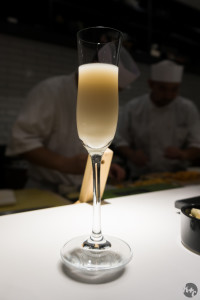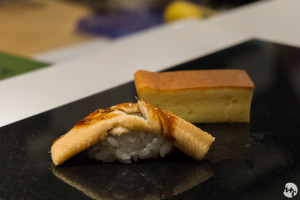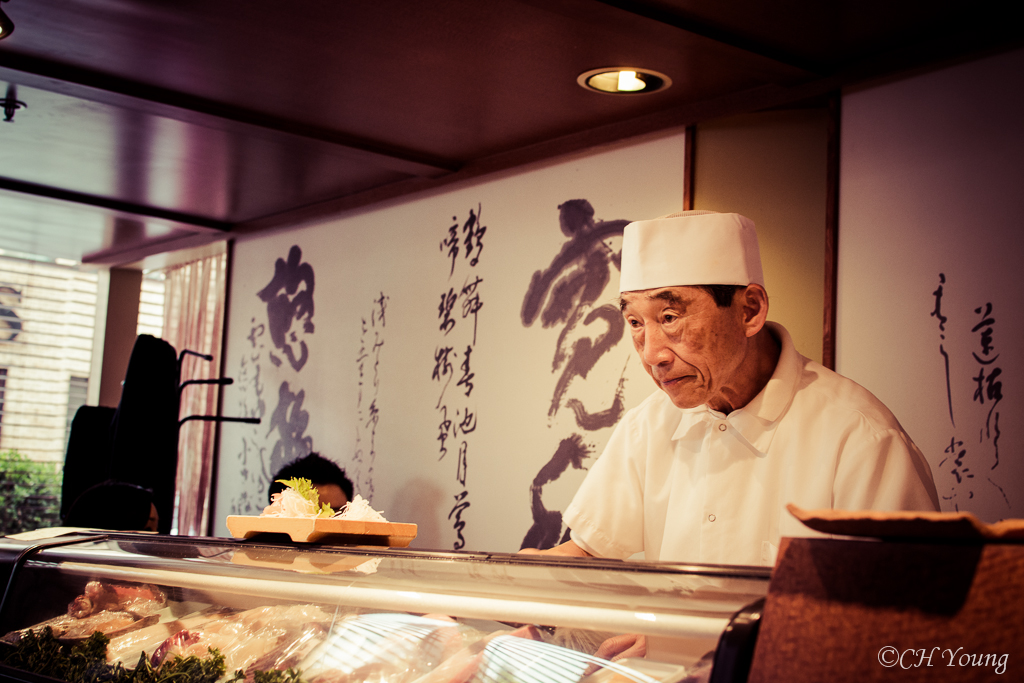The short version of the story goes that Allessandro Borgognone, a veteran of the restaurant industry but new to the world of sushi and Manhattan fine dining, was watching Jiro Dreams of Sushi one night at home and was so inspired that he wanted to open a sushi restaurant in NYC with Chef Nakazawa at the helm. Finding the chef via Facebook, and with the help of Google translate, the two started a conversation. In August 2013, Sushi Nakazawa was officially open.
In just two years, the restaurant has garnered high acclaim, including a coveted four-star review in The New York Times. The restaurant is also the subject of fierce debate as to why it has not yet received a Michelin star. Some say it’s because it’s too difficult to get a reservation. Others say there are improvements needed in the service. I’ve read that Michelin simply doesn’t have enough reviewers to appropriately cover all of the city’s offerings. None of these were issues for us when we dined there on a recent trip in November, and the mere fact that people are debating about why it hasn’t received a Michelin star offers a strong hint of how people feel about this restaurant.
As with any well-reviewed, popular restaurant, you do need to be on your game when it comes to reservations. At Sushi Nakazawa, reservations are released thirty days in advance at midnight. Thinking I had counted back my days accordingly, I practiced making reservations the night before I actually was planning for, when I suddenly realized I was two days off — which is why it’s always wise to practice. But no matter, we were flexible, and the following night I sat down at the computer starting my search several minutes prior, just to be safe. Moments later, I had reservations for two at the sushi bar.
Sushi Nakazawa only serves omakase sushi, whether you sit at the bar or in the dining room. The only difference is the price. You’ll pay an additional twenty-five dollars per person at the bar. That could be considered cheeky, but if you’re able to get reservations at the bar it’s worth the extra money. You get to interface with the charming Chef Nakazawa while being personally served by him, and you get to watch the making of the fascinating art that is sushi; all of which makes for an elevated dining experience.
The restaurant is unassuming from the exterior and you could easily miss it as you walk by, but the interior is chic and modern with a different vibe than your typical sushi restaurant. The bar itself sits high at cocktail bar height, so you get a different perspective of the chefs from the standard table height bar. The bar stools are black leather with backs that make them comfortable, but they do require some assistance from staff to get in and out of. I had read some complaints about service, but I could never detect any issues personally. It was friendly yet professional enough to know you are at a high-end restaurant without feeling at all stuffy.
But all of this is just a lead up to the food; the beautiful, exquisite food. Chef Nakazawa sources much of his fish locally. Coming from the Pacific Northwest, with its abundance of seafood, that really struck me as I forget that the Atlantic is home to its own bounty. Some pieces were reminiscent of what we experienced at Shiro’s and some were quite different, either because of the waters the fish are coming from or because of Nakazawa’s own sensibilities.
As is typical of an omakase meal, the fish selections start light and get heavier as the meal progresses. Chef Nakazawa serves a traditional style sushi, where the fish and the rice are the stars, with only an occasional, restrained enhancement, such as wasabi, citrus, or shiso. There is no soy sauce or wasabi sitting on the bar or tables for patrons to cover up the essence of the story the Chef is trying to tell; only vibrant slivers of pickled ginger to cleanse the palette.
We began with a procession of salmon served three different ways; the third of which was smoked, providing an unusual, delicious twist. Next came a scallop that was still quivering with life, followed by squid enhanced with a fresh shiso leaf. Other delicacies included sable-banded grouper, mackerel served three ways, golden eye snapper, luxurious prawn with caviar, three pieces of tuna from lean to fatty, and much more. When the sea urchin, or uni, came out with two different variations, I once again hoped that at least one of them would be the uni that would make me a convert. Sadly, it still didn’t happen for me, but it did for Craig. The eel, or unagi, was another story, however, and was the best I’ve ever tasted. Served beside tamago — the grilled egg sushi that tastes like custard, and something for which Chef Nakazawa will forever be known for — this pairing was the perfect dessert.
Once the omakase meal finishes, menus are handed out and you can order anything you’d like a la carte. I wished I had room for more, but I felt 100 percent satisfied. A bowl of lychee sorbet finished off the meal.
The restaurant offers a sake pairing with dinner, and while I don’t know much about sake, each pour was a perfect complement to the meal.
Throughout the evening, Chef Nakazawa bantered back and forth with those of us seated at the bar. We told the Chef we remembered him from Shiro’s, showing a photo we took of him that night. He said Shiro had been in New York City just a few weeks earlier and spent some time with him behind his sushi bar. Chef Nakazawa said he’s enjoying the city, and he seemed comfortable and in his element. To have people debating why he hasn’t received a Michelin star after just two years says that he has a bright future ahead and that it’s just a matter of time. I know that, star or no star, I will be planning my next meal at Sushi Nakazawa exactly thirty days in advance of our next trip.
 kimpluscraig.com
kimpluscraig.com








